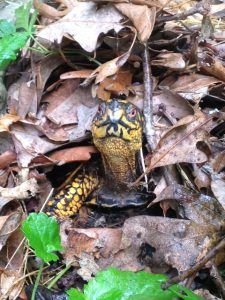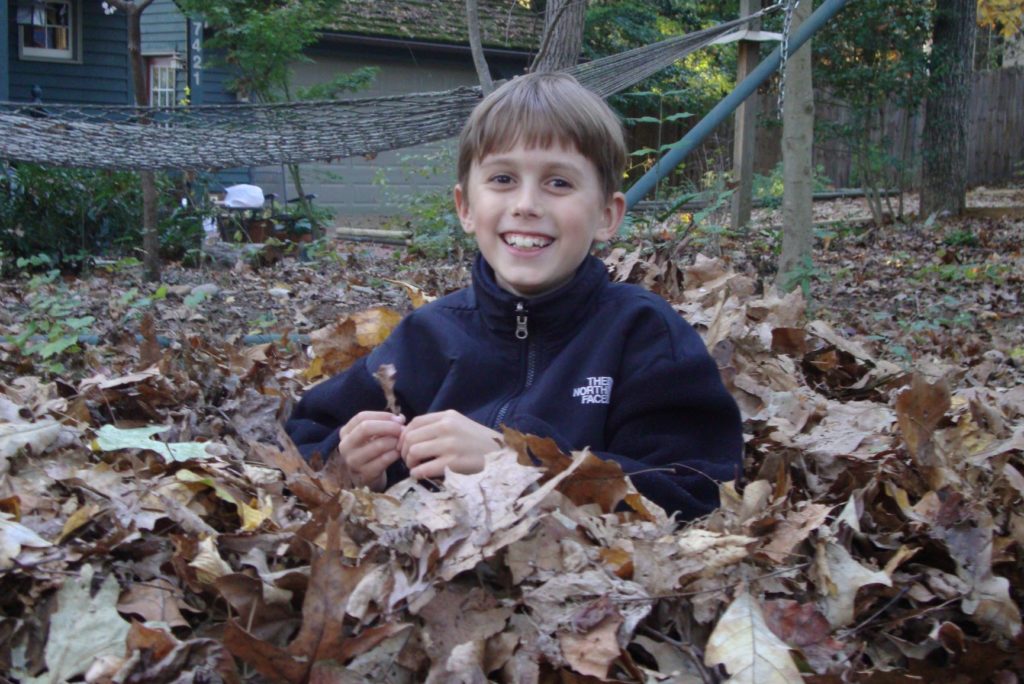It’s Called Leaf Litter, But It’s Not Garbage — Six Reasons to Leave the Leaves
Laura Greenleaf

As I write, wind lashes the bending trees and rust-golden leaves whirl past my window. Great leaf-drifts from our hickory, tulip, black gum, sweetgum, beech, and white, red and post oak trees erase yesterday’s raking and sweeping of walkway and deck. Elsewhere in the neighborhood trash bags bursting with leaves are set out for trash collection while long ridges of leaf piles await their demise by vacuum suction.
I know I’m not entirely alone in declining to wage war on leaves, but I suspect I don’t have much company in my anguish at the sight of leaves destined for landfills. Why grieve for leaves? As with all plant life, they are where the food web begins its great feast, and to borrow from Walt Whitman, they too contain multitudes (rather literally).

I also understand the appeal of some lawn, so I’m not about to suggest anyone abandon theirs. And I know that my own wooded nearly half-acre accommodates far more leaf piles than most city yards. But we all can make modest changes that work for our particular yard. We can reserve an inconspicuous corner for a leaf pile, rake lawn leaves into naturalized areas, beds, or borders, construct wire leaf composters for garden mulch, or reach first for gentler rakes and brooms rather than polluting blowers that are hard on plants, soil, and the hidden life in leaves. Consider the benefits of a different approach to autumn leaves:
Six Reasons to Leave—at least some of—the Leaves
Trees: Mother nature doesn’t make trash. She’s a repurposer and recycler. Trees are producers, making their own food with their leaves via photosynthesis. Shortening fall days and dropping temperatures shut down this production. With green chlorophyll extinguished, the leaves’ true colors emerge in a process called senescence that transfers remaining energy to the tree before the leaves drop (abscission).
But wait! The tree still isn’t done with those leaves. The layers of decomposing leaves that blanket a tree’s root system continue to nourish that tree and its neighbors, releasing nutrients into the soil and keeping it moist. Our trees are stressed enough as it is from droughts, extended record-high summer heat, invasive insects, and disease, plus the heavy invasive wintercreeper and English ivy vine cover that burdens so much of Richmond’s tree canopy. Let’s not scrape away their very own life support system. Senescence is not obsolescence.

- Birds: Ever seen songbirds doing the leaf-tossing “hop and peck”? No? Then you need more leaves! Birds forage in leaves for insects in all their life stages. During the cold months, over-wintering insect larvae in leaf litter are crucial sustenance, and come spring, a clutch of new hatchlings depend on the protein punch of insects, arthropods, and their larvae for their survival. And where will their parents find tens of thousands of meals? Leaf litter. All the birdhouses and feeders in the world don’t add up to bird habitat.

- Other critters: Among those insect larvae in the leaves are the ones we supposedly love – butterflies and fireflies. Unless of course they’re blasted with a 200+ mph leaf blower and/or put out with the trash. Dense, damp leaf litter is an essential element of firefly habitat. All the pollinators we want to attract also depend on a less manicured approach to our yards so they can safely over-winter.
Moving outward in the food web we’ll find other species desperate for us to loosen up and get messy with the yard, like woodland box turtles, which forage for meals in leaf litter and over-winter, buried several centimeters beneath it. Amphibians like salamanders, toads, and frogs and small mammals like chipmunks also make their homes in deep layers of leaves.

- Our river Street gutters and road edges filled with lingering leaf piles ultimately flow with urban and suburban stormwater runoff, carrying the leaves into streams and the James River. This nutrient-rich organic load contributes to impaired water quality because excessive levels of phosphorus and nitrogen deplete oxygen levels (called eutrophication).
So, leave the leaves – but not in the street. My own “leaf management” includes regularly raking and sweeping the natural fall of leaves at the street edge back onto our property and relocating heaps of leaves by wheelbarrow and tarp into setback areas. Here they can do their job of absorbing rain, snow, and ice as they decompose and slowly releasing their moisture into the soil.
- Your — or your landscaping crew’s — health: Leaf blower noise has become such a ubiquitous blow to quality of life that fifteen states regulate their use and over 300 cities restrict or ban gas-powered leaf blowers including Washington, D.C.
The noise pollution is so overwhelming that it’s easy to forget that these small single-cycle engines pack big pollution from emissions plus the airborne clouds of allergens, mold, and (how to put this politely?) animal fecal matter their powerful blasts stir up.
Leaf blowers pose significant respiratory, cardiovascular, and hearing health risks to their users and impact neighbors, pedestrians, runners, and cyclists. Everyone’s health and well-being are good reasons to at least reduce the excessive reliance on leaf blowers. You don’t have to give them up entirely, but consider limiting their use to more targeted tasks, switching to electric models, and taking it easier on the leaves.
- Native plants: If you have a naturalized area of your yard or would like to cultivate one, then you definitely want to leave the leaves. Leaf litter is what makes a forest, and it’s essential to your own little woodland for both nourishing the germination and growth of naturally occurring native species and creating the right conditions for the local species you plant.

You know the slogan “Peace begins at home”? May it begin in our yards.

Laura Greenleaf is a Certified Virginia Master Naturalist and a founding steering committee member of the James River Park System Invasive Plant Task Force. She lives near the Pony Pasture section of the park system.


